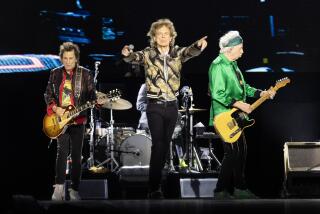Famous Rock Magazine Turns 20--and It’s Rolling in Affluence
- Share via
Perception: At its 20th birthday bash, Rolling Stone magazine might serve marijuana-laced brownies on recycled paper plates.
Reality: At the West Coast celebration at the posh Pacific Stock Exchange nightclub in Los Angeles last week, delicate hors d’oeuvres were served on silver platters.
After two decades, no matter what the public’s perception, a growing number of advertisers are discovering the reality: Rolling Stone is mostly read by the well-off. About half of its readers are professionals who were graduated from college and have annual household incomes above $30,000.
“We didn’t suddenly decide to reposition ourselves as the baby boom magazine,” said Jann S. Wenner, editor, publisher and founder of Rolling Stone. “We are that magazine.”
Yet for the past two years, the magazine has spent more than $1 million on a tongue-in-cheek ad campaign that relies entirely on contrasting images to make a point: Rolling Stone readers are basically an older, wealthier, more conservative lot than some people might think. “We’re not really running the ads to correct any false impressions,” winks Wenner, “we’re running them to have a little fun.”
But life has not always been so much fun at Rolling Stone. The magazine began as a counterculture music journal in 1967, turned marginally mainstream a decade later and lost a number of hard-core rock readers by the 1980s, when it began running cover stories on the likes of Mary Tyler Moore, Brooke Shields and even Bob Hope. In the last few years, however, it has mostly returned to its musical roots.
After all, baby boomers still love rock music. But now, they listen to it on their compact disc players while supper hums in the microwave.
Under the headline “Perception,” one Rolling Stone ad shows some spare change scattered on an otherwise blank page. But on the page across from it, under the headline “Reality,” an American Express card tells the true story of the Rolling Stone reader. The ad, created by the Minneapolis-based ad firm Fallon McElligott, notes that more than half the magazine’s 1-million-plus readers carry credit cards.
Similarly, another Rolling Stone ad, under the headline “Perception,” shows a longhaired, bearded hippie, with love beads dangling from his neck. On the next page, however, under the headline “Reality,” sits a clean-cut, go-getter in a designer sport coat, who looks like he just stepped out of Brooks Bros.
Because of its demographics, Rolling Stone is really rolling--in dough. Although its first issue cost a quarter, today the cover price is $2.25--and even more for some special issues. With four of these special issues produced during this anniversary year, the magazine estimates that it will post record ad revenue and ad pages.
‘Reaching a Peak’
During the first three quarters of 1987, Rolling Stone sold a record 1,209 pages of advertising, a 24.8% jump from the same period in 1986. At the same time, its ad revenue for the first three quarters totaled $28.2 million, 33.5% higher than the same 1986 period, due, in part, to higher ad rates. Today, a single page, four-color ad in the magazine costs $33,405, compared to $30,705 in 1986.
“Rolling Stone seems to be reaching a peak,” said Samir Husni, a journalism professor at the University of Mississippi, who tracks the magazine industry. “The question is, can they continue to keep up the pace?”
Randy Jones doesn’t think so. The publisher of Esquire magazine--which competes with Rolling Stone for some advertisers--says that after this anniversary year, “their numbers will almost certainly drop.”
In Rolling Stone’s first issue--Nov. 9, 1967--about the only advertisers the magazine could attract were a half-dozen concert promoters. But many of the advertisers in its recent 20th anniversary issue--dated Aug. 27, 1987--could as comfortably appear in Town & Country. These include Ralph Lauren, American Express, Reebok and Haagen-Dazs.
The life styles of Rolling Stone readers have changed as radically as the magazine’s advertisers. For example, in 1979, only 12.4% of the magazine’s readers had annual household incomes exceeding $35,000. Today, 42% of them do. In 1979, the median household income of the Rolling Stone reader was $18,649. Today, it’s $30,664.
That buys a lot of Haagen-Dazs ice cream.
“Not too many years ago, I was calling on a lot of people who didn’t know what Rolling Stone was,” Wenner said. “Now people who are in decision-making positions at major ad agencies are calling on us.”
Among Rolling Stone’s biggest advertisers are car makers, liquor companies and tobacco companies. Nissan has been running ads in Rolling Stone for six years. “Rolling Stone delivers a terrific audience,” said Terry Foutz, national car advertising manager at Nissan. Earlier this year, when American Express began its biggest-ever print advertising campaign, Rolling Stone was one of the 40 magazines it selected for the full-page ads. “Very simply, the magazine meets our criteria,” said Joan Bonnette, vice president of consumer advertising at the company.
But not all advertisers are racing to get into the publication. Although Rolling Stone recently began chasing after some big-time food advertisers such as Del Monte and the National Dairy Council, it has landed only a few. Financial institutions have been slow to sign up. “Sure, it’s tough to crack new categories,” said Bill Harper, the magazine’s West Coast advertising manager, “but most advertisers are aware that we’re not a hippie-dippie magazine anymore.”
When Rolling Stone ad sales representatives go prospecting for new advertisers, they like to compare the magazine’s demographics to Esquire and GQ. After all, nearly 62% of Rolling Stone’s readers are male. Indeed, in the 25- to 39-year-old bracket, Rolling Stone claims to have twice as many readers as Esquire with household incomes of $30,000 or more.
But Esquire says its readers are a far more upscale breed than that of Rolling Stone. “The thought of drawing a comparison with Rolling Stone has never even crossed my mind,” said Esquire publisher Jones.
Some critics contend that as Rolling Stone grows fat with mainstream advertising, its editorial gusto has grown thin.
“They’re nowhere near the cutting edge anymore--and haven’t been for years,” said Doug Simmons, music editor of the Village Voice.
“Rolling Stone is now the bible of the yuppie generation,” said Bob C. Guccione Jr., editor and publisher of the only true competitor that Rolling Stone faces, a 2-year-old, financially ailing magazine called Spin that was underwritten by Guccione’s father, Penthouse publisher Robert Guccione. “Rolling Stone has discovered that there’s more money to be made as the magazine of the suburbs than one of urban warfare.”
Offbeat Ads Poke Fun at Market Commercials
Look out Shirley Jones, Stephanie Edwards and Anne Lockhart. Here comes Roseanne Barr.
Roseanne who? The first three women have become familiar to Southland TV viewers in their ever-so-cheery ads for Ralphs, Lucky and Alpha Beta.
But now, in the name of the Giant, a grocery chain in search of an image, an off-the-wall comedian is about to try to put nicy-nice supermarket ads on the shelf.
Barr frequently plays a disgruntled housewife in nightclub skits and “Tonight Show” appearances. She will play that same role in a series of ads that are scheduled to premiere next week for the Compton-based supermarket chain.
The $2-million campaign is a bid by the Giant--whose parent company is Ralphs Grocery Co.--to poke fun at the toothy, full-of-promises spokeswomen that competing supermarket chains continue to use in their advertising.
One thing is for sure: The ads are provocative. Barr, who is a hefty woman, pushes her weight around in the offbeat ads by doing such things as jamming a huge blueberry muffin into her mouth and jabbing her finger into a turkey while commenting that it resembles her husband.
Nancy Shalek, general manager of the West Coast office of W. B. Doner & Co., the ad firm that created the ads, says the way to get noticed in the ultra-competitive supermarket arena is to turn left when everyone else turns right. “If we can just get people to watch the ads, we’ll be way ahead of the game.”
Backer Spielvogel Gets Northrop Account
Aerospace giant Northrop, which has had three ad agencies in the past three years, handed its $5-million corporate advertising account to Backer Spielvogel Bates late Monday.
“Northrop is a tough account,” said Jim Taft, director of corporate advertising for the Los Angeles-based company. “We’re in a different type of industry than most ad agencies are used to dealing with.”
The advertising will be handled by both the New York and Huntington Beach offices of Backer Spielvogel. New ads should break in October. Taft said that the company’s current slogan, “Making Advanced Technology Work,” will probably be scrapped.
More to Read
The biggest entertainment stories
Get our big stories about Hollywood, film, television, music, arts, culture and more right in your inbox as soon as they publish.
You may occasionally receive promotional content from the Los Angeles Times.







